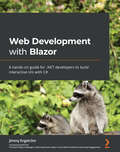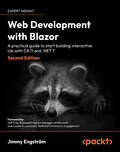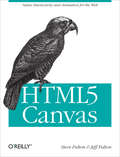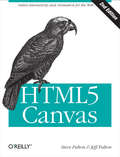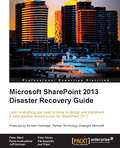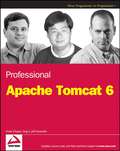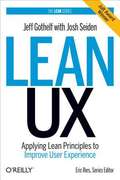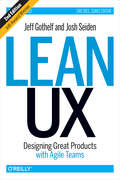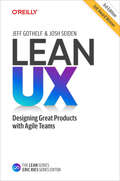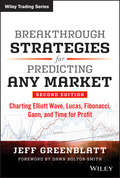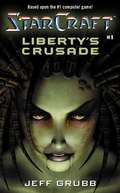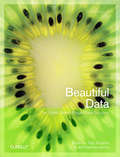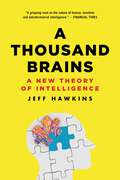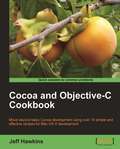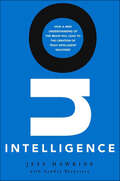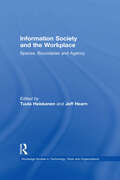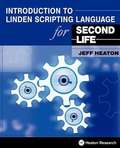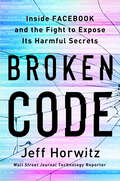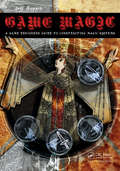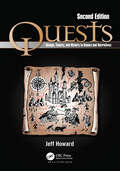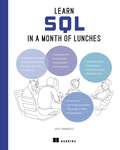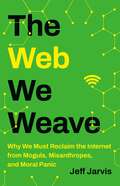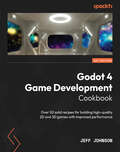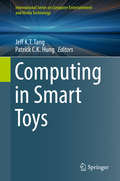- Table View
- List View
Web Development with Blazor: A hands-on guide for .NET developers to build interactive UIs with C#
by Jimmy Engstrom Jeff FritzDevelop modern web UIs quickly with server-side Blazor and Blazor WebAssemblyKey FeaturesCreate and deploy a production-ready Blazor application from start to finishLearn Blazor fundamentals, gain actionable insights, and discover best practicesFind out how, when, and why to use server-side Blazor and Blazor WebAssemblyBook DescriptionBlazor is an essential tool if you want to build interactive web apps without JS, but it comes with its own learning curve. Web Development with Blazor will help you overcome most common challenges developers face when getting started with Blazor and teach you the best coding practices.You'll start by learning how to leverage the power of Blazor and explore the full capabilities of both Blazor Server and Blazor WebAssembly.Then you'll move on to the practical part, which is centred around a sample project – a blog engine. This is where you'll apply all your newfound knowledge about creating Blazor Server and Blazor WebAssembly projects, the inner working of Razor syntax, and validating forms, as well as creating your own components. You'll learn all the key concepts involved in web development with Blazor, which you'll also be able to put into practice straight away.By showing you how all the components work together practically, this book will help you avoid some of the common roadblocks that novice Blazor developers face and inspire you to start experimenting with Blazor on your other projects.When you reach the end of this Blazor book, you'll have gained the confidence you need to create and deploy production-ready Blazor applications.What you will learnUnderstand the different technologies that can be used with Blazor, such as Blazor Server and Blazor WebAssemblyFind out how to build simple and advanced Blazor componentsExplore the differences between Blazor Server and Blazor WebAssembly projectsDiscover how Entity Framework works and build a simple APIGet up to speed with components and find out how to create basic and advanced componentsExplore existing JavaScript libraries in BlazorUse techniques to debug your Blazor Server and Blazor WebAssembly applicationsTest Blazor components using bUnitWho this book is forIf you're a .NET web or software developer who wants to build web UIs using C#, then this book is for you. You'll need intermediate-level web-development skills and basic knowledge of C# before you get started; the book will guide you through the rest.
Web Development with Blazor: A practical guide to start building interactive UIs with C# 11 and .NET 7, 2nd Edition
by Jimmy Engstrom Jeff FritzDevelop modern web UIs with Blazor Server and Blazor WebAssemblyPurchase of the print or Kindle book includes a free eBook in PDF format.Key FeaturesCreate a production-ready Blazor application from start to finishLearn Blazor fundamentals, gain actionable insights, and discover best practicesFind out how, when, and why to use Blazor Server and Blazor WebAssembly, as well as Blazor HybridBook DescriptionBlazor is an essential tool if you want to build interactive web apps without JavaScript, but it has a learning curve. Updated with the latest code in .NET 7 and C# 11 and written by someone who adopted Blazor early, this book will help you overcome the challenges associated with being a beginner with Blazor and teach you the best coding practices. You'll start by learning how to leverage the power of Blazor and exploring the full capabilities of both Blazor Server and Blazor WebAssembly. Then you'll move on to the practical part, centered around a sample project – a blog engine. You'll apply all your newfound knowledge about creating Blazor projects, the inner workings of Razor syntax, validating forms, and creating your own components. This new edition also looks at source generators, dives deeper into Blazor WebAssembly with ahead-of-time, and includes a dedicated new chapter demonstrating how to move components of an existing JavaScript (Angular, React) or MVC-based website to Blazor or combine the two. You'll also see how to use Blazor (Hybrid) together with .NET MAUI to create cross-platform desktop and mobile applications. When you reach the end of this book, you'll have the confidence you need to create and deploy production-ready Blazor applications, and you'll have a big-picture view of the Blazor landscape.What you will learnUnderstand the different technologies that can be used with Blazor, such as Blazor Server, Blazor WebAssembly, and Blazor HybridFind out how to build simple and advanced Blazor componentsExplore the differences between Blazor Server and Blazor WebAssembly projectsDiscover how Minimal APIs work and build your own APIExplore existing JavaScript libraries in Blazor and JavaScript interoperabilityLearn techniques to debug your Blazor Server and Blazor WebAssembly applicationsTest Blazor components using bUnitWho this book is forThis book is for .NET web developers and software developers who want to use their existing C# skills to build interactive SPA applications running either inside the web browser using Blazor WebAssembly, or on the server using Blazor Server.You'll need intermediate-level web-development skills, basic knowledge of C#, and prior exposure to .NET web development before you get started; the book will guide you through the rest.
HTML5 Canvas: For Games And Entertainment
by Steve Fulton Jeff FultonNo matter what platform or tools you use, the HTML5 revolution will soon change the way you build web applications, if it hasn't already. HTML5 is jam-packed with features, and there's a lot to learn. This book gets you started with the Canvas element, perhaps HTML5's most exciting feature. Learn how to build interactive multimedia applications using this element to draw, render text, manipulate images, and create animation. Whether you currently use Flash, Silverlight, or just HTML and JavaScript, you'll quickly pick up the basics. Practical examples show you how to create various games and entertainment applications with Canvas as you learn. Gain valuable experience with HTML5, and discover why leading application developers rave about this specification as the future of truly innovative web development. Create and modify 2D drawings, text, and bitmap images Incorporate and manipulate video, and add audio Build a basic framework for creating a variety of games on Canvas Use bitmaps and tile sheets to develop animated game graphics Go mobile: port Canvas applications to iPhone with PhoneGap Explore ways to use Canvas for 3D and multiplayer game applications
HTML5 Canvas: Native Interactivity and Animation for the Web
by Steve Fulton Jeff FultonFlash is fading fast as Canvas continues to climb. The second edition of this popular book gets you started with HTML5 Canvas by showing you how to build interactive multimedia applications. You’ll learn how to draw, render text, manipulate images, and create animation—all in the course of building an interactive web game throughout the book.Updated for the latest implementations of Canvas and related HTML5 technologies, this edition includes clear and reusable code examples to help you quickly pick up the basics—whether you currently use Flash, Silverlight, or just HTML and JavaScript. Discover why HTML5 is the future of innovative web development.Create and modify 2D drawings, text, and bitmap imagesUse algorithms for math-based movement and physics interactionsIncorporate and manipulate video, and add audioBuild a basic framework for creating a variety of gamesUse bitmaps and tile sheets to develop animated game graphicsGo mobile: build web apps and then modify them for iOS devicesExplore ways to use Canvas for 3D and multiplayer game applications
Microsoft SharePoint 2013 Disaster Recovery Guide
by Peter Ward Pat Esposito Peter Abreu Joel Plaut Jeff Gellman Pavlo AndrushkiwThe style and approach of the book is an easytoread SharePoint admin guide. This is not a stepbystep instruction book, but rather a guide on how to implement and execute a disaster recovery plan to your SharePoint environment.This book is great for both SharePoint and SQL administrators new to the SharePoint 2013 architecture, and who are looking to get a good grounding in how to use implement a solid disaster recoveryrecovery plan. It's assumed that you have some experience in SharePoint and Windows Server and, as well be familiar with SQL.
Professional Apache Tomcat 6
by Sing Li Vivek Chopra Jeff GenenderTomcat is the official reference implementation of Sun's servlet and JSP specifications, and Java developers must test all Web applications on Tomcat to ensure they work as designedBoasting more than 40 percent new and updated material, this book covers all the major new features affecting server administration and managementExplores the additional built-in tools of Tomcat, which help Java developers program more efficiently, and looks at how Apache's other open source servlet/JSP technologies are designed to work with TomcatFeatures full coverage of Release 6, which supports the latest JSP and servlet specifications: JSP 2.1 and Servlets 2.5Addresses solving real-world problems encountered during all phases of server administration, including managing class loaders and connectors, security, shared hosting and clustering, and system testing
Lean UX: Applying Lean Principles to Improve User Experience
by Jeff Gothelf Josh Seiden<p>The Lean UX approach to interaction design is tailor-made for today’s web-driven reality. In this insightful book, leading advocate Jeff Gothelf teaches you valuable Lean UX principles, tactics, and techniques from the ground up—how to rapidly experiment with design ideas, validate them with real users, and continually adjust your design based on what you learn.</p>
Lean UX: Designing Great Products with Agile Teams
by Jeff Gothelf Josh SeidenUX design has traditionally been deliverables-based. Wireframes, site maps, flow diagrams, content inventories, taxonomies, mockups helped define the practice in its infancy.Over time, however, this deliverables-heavy process has put UX designers in the deliverables business. Many are now measured and compensated for the depth and breadth of their deliverables instead of the quality and success of the experiences they design. Designers have become documentation subject matter experts, known for the quality of the documents they create instead of the end-state experiences being designed and developed.So what's to be done? This practical book provides a roadmap and set of practices and principles that will help you keep your focus on the the experience back, rather than the deliverables.Get a tactical understanding of how to successfully integrate Lean and UX/DesignFind new material on business modeling and outcomes to help teams work more strategicallyDelve into the new chapter on experiment designTake advantage of updated examples and case studies
Lean UX: Designing Great Products with Agile Teams
by Jeff Gothelf Josh SeidenLean UX is synonymous with modern product design and development. By combining human-centric design, agile ways of working, and a strong business sense, designers, product managers, developers, and scrum masters around the world are making Lean UX the leading approach for digital product teams today.In the third edition of this award-winning book, authors Jeff Gothelf and Josh Seiden help you focus on the product experience rather than deliverables. You'll learn tactics for integrating user experience design, product discovery, agile methods, and product management. And you'll discover how to drive your design in short, iterative cycles to assess what works best for businesses and users. Lean UX guides you through this change--for the better.Facilitate the Lean UX process with your team with the Lean UX CanvasEnsure every project starts with clear customer-centric success criteriaUnderstand the role of designer on an agile teamWrite and contribute design and experiment stories to the backlogEnsure that design work takes place in every sprintBuild product discovery into your team's "velocity"
Breakthrough Strategies for Predicting Any Market: Charting Elliott Wave, Lucas, Fibonacci, Gann, and Time for Profit (Wiley Trading #53)
by Jeff GreenblattThe revised and updated edition of the book that changed the way you think about trading In the Second Edition of this groundbreaking book by star trader Jeff Greenblatt, he continues to shares his hard-won lessons on what it takes to be a professional trader, while detailing his proven techniques for mastering market timing. With the help of numerous case studies and charts, Greenblatt develops his original high-probability pattern recognition system which, once mastered, endows its user with a deeper understanding of how the markets really work and boosts the efficiency of any trading methodology. Following in the footsteps of the great W.D. Gann, Jeff Greenblatt helps investors gain greater precision with any instrument they trade, during any time frame. Shows how to combine a variety of technical indicators to pinpoint turning points in the financial markets Makes even the most complex subject matter easy to understand with crystal-clear explanations and step-by-step guidance on all concepts, terms, processes, and techniques Reveals how to use Elliott Wave Analysis, Fibonacci, candlesticks, and momentum indicators to interpret market movements Breakthrough Strategies for Predicting Any Market shares fascinating and enlightening personal anecdotes from Jeff Greenblatt's career along with his candid reflection on developing and maintaining the mental discipline of a successful trader.
Liberty's Crusade
by Jeff GrubbFar in the future, 60,000 light-years from Earth, a loose confederacy of Terran exiles is locked in battle with the enigmatic Protoss and the ruthless Zerg Swarm. Each species struggles to ensure its own survival among the stars in a war that will herald the beginning of mankind's greatest chapter -- or foretell its violent, bloody end. Danny Liberty was a good reporter...too good. When his investigations struck too close to the heart of the corrupt Terran Confederacy, he faced a simple choice: continue his current series of exposés, or take a hazardous new assignment covering the Marines on the front lines of the Koprulu Sector. It didn't take him long to decide.... Behind the attacks of the Zerg and the Protoss lies the story of a lifetime, but every piece of information blurs the mystery further. Thrown into the middle of a war where the outcome will determine mankind's very survival, the only thing that Danny Liberty knows for sure is that the only person he can trust to keep him alive is himself. Liberty's Crusade The first in an epic new series of space warfare novels set in the world of the bestselling computer game!
Beautiful Data: The Stories Behind Elegant Data Solutions
by Toby Segaran Jeff HammerbacherIn this insightful book, you'll learn from the best data practitioners in the field just how wide-ranging -- and beautiful -- working with data can be. Join 39 contributors as they explain how they developed simple and elegant solutions on projects ranging from the Mars lander to a Radiohead video.With Beautiful Data, you will:Explore the opportunities and challenges involved in working with the vast number of datasets made available by the WebLearn how to visualize trends in urban crime, using maps and data mashupsDiscover the challenges of designing a data processing system that works within the constraints of space travelLearn how crowdsourcing and transparency have combined to advance the state of drug researchUnderstand how new data can automatically trigger alerts when it matches or overlaps pre-existing dataLearn about the massive infrastructure required to create, capture, and process DNA dataThat's only small sample of what you'll find in Beautiful Data. For anyone who handles data, this is a truly fascinating book. Contributors include:Nathan YauJonathan Follett and Matt HolmJ.M. HughesRaghu Ramakrishnan, Brian Cooper, and Utkarsh SrivastavaJeff HammerbacherJason Dykes and Jo WoodJeff Jonas and Lisa SokolJud ValeskiAlon Halevy and Jayant MadhavanAaron Koblin with Valdean KlumpMichal MigurskiJeff HeerCoco KrummePeter NorvigMatt Wood and Ben BlackburneJean-Claude Bradley, Rajarshi Guha, Andrew Lang, Pierre Lindenbaum, Cameron Neylon, Antony Williams, and Egon WillighagenLukas Biewald and Brendan O'ConnorHadley Wickham, Deborah Swayne, and David PooleAndrew Gelman, Jonathan P. Kastellec, and Yair GhitzaToby Segaran
A Thousand Brains: A New Theory of Intelligence
by Jeff HawkinsA bestselling author, neuroscientist, and computer engineer unveils a theory of intelligence that will revolutionize our understanding of the brain and the future of AI. For all of neuroscience's advances, we've made little progress on its biggest question: How do simple cells in the brain create intelligence? Jeff Hawkins and his team discovered that the brain uses maplike structures to build a model of the world-not just one model, but hundreds of thousands of models of everything we know. This discovery allows Hawkins to answer important questions about how we perceive the world, why we have a sense of self, and the origin of high-level thought. A Thousand Brains heralds a revolution in the understanding of intelligence. It is a big-think book, in every sense of the word.
Cocoa and Objective-C Cookbook
by Jeff HawkinsWritten in a cookbook style, this book offers solutions using a recipe-based approach. Each recipe contains step-by-step instructions followed by an analysis of what was done in each task and other useful information. The cookbook approach means you can dive into whatever recipes you want in no particular order. This book is perfect for the Mac OS X Cocoa developer who is ready to move beyond the basics and dive into more advanced Cocoa topics. The cookbook format lets you jump right into the examples without the lengthy explanations you often find in other books. Basic familiarity with Cocoa and Objective-C development is required.
On Intelligence: How a New Understanding of the Brain Will Lead to the Creation of Truly Intelligent Machines
by Sandra Blakeslee Jeff HawkinsThe inventor of the PalmPilot shares a compelling new theory of intelligence, brain function, and the future of artificial intelligence.Tech innovator Jeff Hawkins reshaped our relationship to computers with devices like the PalmPilot. Now he stands ready to revolutionize both neuroscience and computing in one stroke, with a new understanding of intelligence itself. In this book, Hawkins develops a powerful theory of human cognition and explains how, based on his theory, we can finally build intelligent machines.According to Hawkins, the brain is a complex system that remembers sequences of events and their nested relationships. This style of organization reflects the true structure of the world and allows us to make increasingly accurate predictions. This memory-prediction process in turn forms the basis of intelligence, perception, creativity, and even consciousness.In an engaging style accessible to the general reader, Hawkins shows how a clear understanding of brain function can be applied to building intelligent machines, in silicon, that will exceed our human ability in surprising ways. Written with acclaimed science writer Sandra Blakeslee, On Intelligence is a landmark book in its scope and clarity.“Brilliant and imbued with startling clarity . . . the most important book in neuroscience, psychology, and artificial intelligence in a generation.” —Malcolm Young, University of Newcastle
Information Society and the Workplace: Spaces, Boundaries and Agency (Routledge Studies in Technology, Work and Organizations #Vol. 1)
by Jeff Hearn Tuula HeiskanenMuch has been written on the grand prospects for "Information Society"; much less on what this might mean in everyday terms. So what do we find when we look at what is happening in a society, Finland, that is one of closest to an information society? Bringing together studies of everyday local practices in workplaces within information society, this book has a special focus on social space and the agency of actors. It includes both theoretical reviews and detailed qualitative research. It also highlights the political challenges of the information society, challenges which are likely to become subjects of international concern.
Introduction to Linden Scripting Language for Second Life
by Jeff HeatonThe Linden Scripting Language allows residents of the Second Life World to program the three dimensional objects around them. Without this programming objects built in Second Life are motionless and non-interactive. Adding a script enables an object to interact with the world around it. Second Life scripts allow objects such as cars, planes, amusement park rides, weapons and other entertainment devices to be created. This book teaches the beginning Second Life programmer to make use of the basics of the Linden Scripting Language. Language fundamentals, such as variables, loops, lists, events, functions and state machines are covered. The book then moves to more advanced topics such as user interaction and non-physical movement. Later chapters show how to use the Second Life physics engine to create vehicles.
Broken Code: Inside Facebook and the Fight to Expose Its Harmful Secrets
by Jeff HorwitzBy an award-winning technology reporter for The Wall Street Journal, a behind-the-scenes look at the manipulative tactics Facebook used to grow its business, how it distorted the way we connect online, and the company insiders who found the courage to speak out"Broken Code fillets Facebook&’s strategic failures to address its part in the spread of disinformation, political fracturing and even genocide. The book is stuffed with eye-popping, sometimes Orwellian statistics and anecdotes that could have come only from the inside." —New York Times Book ReviewOnce the unrivaled titan of social media, Facebook held a singular place in culture and politics. Along with its sister platforms Instagram and WhatsApp, it was a daily destination for billions of users around the world. Inside and outside the company, Facebook extolled its products as bringing people closer together and giving them voice.But in the wake of the 2016 election, even some of the company&’s own senior executives came to consider those claims pollyannaish and simplistic. As a succession of scandals rocked Facebook, they—and the world—had to ask whether the company could control, or even understood, its own platforms.Facebook employees set to work in pursuit of answers. They discovered problems that ran far deeper than politics. Facebook was peddling and amplifying anger, looking the other way at human trafficking, enabling drug cartels and authoritarians, allowing VIP users to break the platform&’s supposedly inviolable rules. They even raised concerns about whether the product was safe for teens. Facebook was distorting behavior in ways no one inside or outside the company understood. Enduring personal trauma and professional setbacks, employees successfully identified the root causes of Facebook's viral harms and drew up concrete plans to address them. But the costs of fixing the platform—often measured in tenths of a percent of user engagement—were higher than Facebook's leadership was willing to pay. With their work consistently delayed, watered down, or stifled, those who best understood Facebook&’s damaging effect on users were left with a choice: to keep silent or go against their employer.Broken Code tells the story of these employees and their explosive discoveries. Expanding on &“The Facebook Files,&” his blockbuster, award-winning series for The Wall Street Journal, reporter Jeff Horwitz lays out in sobering detail not just the architecture of Facebook&’s failures, but what the company knew (and often disregarded) about its societal impact. In 2021, the company would rebrand itself Meta, promoting a techno-utopian wonderland. But as Broken Code shows, the problems spawned around the globe by social media can&’t be resolved by strapping on a headset.
Game Magic: A Designer's Guide to Magic Systems in Theory and Practice
by Jeff HowardMake More Immersive and Engaging Magic Systems in GamesGame Magic: A Designer's Guide to Magic Systems in Theory and Practice explains how to construct magic systems and presents a compendium of arcane lore, encompassing the theory, history, and structure of magic systems in games and human belief. The author combines rigorous scholarly analysis wi
Quests: Design, Theory, and History in Games and Narratives
by Jeff HowardCombining theory and practice, this updated new edition provides a complete overview of how to create deep and meaningful quests for games. It uses the Unity game engine in conjunction with Fungus and other free plugins to provide an accessible entry into quest design. The book begins with an introduction to the theory and history of quests in games, before covering four theoretical components of quests: their spaces, objects, actors, and challenges. Each chapter also includes a practical section, with accompanying exercises and suggestions for the use of specific technologies for four crucial aspects of quest design: • level design • quest item creation • NPC and dialogue construction • scripting This book will be of great interest to all game designers looking to create new, innovative quests in their games. It will also appeal to new media researchers, as well as humanities scholars in the fields of mythology and depth-psychology that want to bring computer-assisted instruction into their classroom in an innovative way. The companion website includes lecture and workshop slides, and can be accessed at: www.designingquests.com
Learn SQL in a Month of Lunches (In a Month of Lunches)
by Jeff IannucciUse SQL to get the data you need in no time at all! Learn to read and write basic queries, troubleshoot common problems, and control your own business data in just 24 short lessons–no programming experience required!SQL has been designed to be as close to English as possible—anyone can learn it! Learn SQL in a Month of Lunches helps you add this lucrative and highly sought-after skill to your resume in just 24 fun and friendly lessons. The book emphasizes practical uses for the language in the real-world, so you&’ll just learn the most useful skills for business data analysis. Inside Learn SQL in a Month of Lunches you&’ll discover how to: • Set up your first database with MySQL • Write your own SQL queries • See only the data you need from large datasets • Connect different sets of data • Analyze data with functions and aggregations • Master basic data manipulation techniques • Save queries in stored procedures and views • Create tables to store data efficiently • Read and improve SQL written by others If you use Excel, Tableau, or PowerBI to crunch business data, you&’ve probably seen a lot of SQL already. And guess what? It&’s easy to master the most useful parts of SQL! In just a few quick lessons, Learn SQL in a Month of Lunches will get you writing your own queries, modifying existing SQL statements, and working with data like a pro. 25-year SQL veteran Jeff Iannucci makes SQL a snap through hands-on lab exercises, relevant code examples, and easy-to-understand language. About the technology SQL, Structured Query Language, is the standard way to query, create, and manage relational databases like SQL Server, PostgreSQL, and Oracle. It&’s also a superpower for data analysts who need to go beyond spreadsheets and BI dashboarding tools. SQL is easy to read and understand, and with this book (and a little practice) you&’ll be pulling data, tweaking tables, and cranking out amazing reports and presentations in no time at all! About the book Learn SQL in a Month of Lunches introduces SQL to data analysts and other aspiring data pros with no prior experience using relational databases. In it, you&’ll complete 24 short lessons, each of which teaches an essential SQL skill for retrieving, filtering, and analyzing data. You&’ll practice each new technique with a friendly hands-on lab designed to take about 15 minutes, as you learn to write queries that deliver the exact data you need. Along the way, you&’ll build a valuable intuition for how databases operate in real business scenarios. What's inside • Get the data you need from any relational database • Filter, sort, and group data • Combine data from multiple tables • Create, update, and delete data About the reader For students, aspiring data analysts, software developers, and anyone else who wants to work with relational databases. About the author Jeff Iannucci is a Senior Consultant with Straight Path Solutions. For over 20 years, he has worked extensively with SQL in sectors such as healthcare, finance, retail sales, and government. Table of Contents 1 Before you begin 2 Your first SQL query 3 Querying data 4 Sorting, skipping, and commenting data 5 Filtering on specific values 6 Filtering with multiple values, ranges, and exclusions 7 Filtering with wildcards and null values 8 Querying multiple tables 9 Using different kinds of joins 10 Combining queries with set operators 11 Using subqueries and logical operators 12 Grouping data 13 Using variables 14 Querying with functions 15 Combining or calculating values with functions 16 Inserting data 17 Updating and deleting data 18 Storing data in tables 19 Creating constrai
The Web We Weave: Why We Must Reclaim the Internet from Moguls, Misanthropes, and Moral Panic
by Jeff JarvisA bold defense of the internet, arguing attempts to fix and regulate it are often misguided —"essential reading for anyone who cares about the future of the internet" (Taylor Lorenz, author of Extremely Online) The internet stands accused of dividing us, spying on us, making us stupid, and addicting our children. In response, the press and panicked politicians seek greater regulation and control, which could ruin the web before we are finished building it. Jeff Jarvis is convinced we can have a saner conversation about the internet. Examining the web&’s past, present, and future, he shows that many of the problems the media lays at the internet&’s door are the result of our own failings. The internet did not make us hate; we brought our bias, bigotry, and prejudice with us online. That&’s why even well-intentioned regulation will fail to fix hate speech and misinformation and may instead imperil the freedom of speech the internet affords to all. Once we understand the internet for what it is—a human network—we can reclaim it from the nerds, pundits, and pols who are in charge now and turn our attention where it belongs: to fostering community, conversation, and creativity online. The Web We Weave offers an antidote to today&’s pessimism about the internet, outlining a bold vision for a world with a web that works for all of us.
Designing With the Mind in Mind: Simple Guide to Understanding User Interface Design Guidelines
by Jeff JohnsonUser interface (UI) design rules and guidelines, developed by early HCI gurus and recognized throughout the field, were based on cognitive psychology (study of mental processes such as problem solving, memory, and language), and early practitioners were well informed of its tenets. But today practitioners with backgrounds in cognitive psychology are a minority, as user interface designers and developers enter the field from a wide array of disciplines. <p><p>HCI practitioners today have enough experience in UI design that they have been exposed to UI design rules, but it is essential that they understand the psychological basis behind the rules in order to effectively apply them. In Designing with the Mind in Mind, best-selling author Jeff Johnson provides designers with just enough background in perceptual and cognitive psychology that UI design guidelines make intuitive sense rather than being just a list of rules to follow.
Godot 4 Game Development Cookbook: Over 50 solid recipes for building high-quality 2D and 3D games with improved performance
by Jeff JohnsonExplore the latest features of Godot 4 using advanced techniques and recipes to create professional-grade games with increased efficiencyPurchase of the print or Kindle book includes a free PDF eBookKey FeaturesTake advantage of the new Vulkan renderer and 3D physics in Godot 4 to create high-quality gamesStreamline your game development workflow with Godot's new TileMap, TileSet, and Animation Editor featuresDiscover what's changed in GDScript 2.0 and Shader additions to enhance your game development skillsBook DescriptionWant to transition from Godot 3 to 4? Look no further than the Godot 4 Game Development Cookbook. This comprehensive guide covers everything you need to become proficient with the latest GUI, GDscript 2.0, Vulkan 2D/3D rendering, shaders, audio, physics, TileSet/TileMap, importing, sound/music, animation, and multiplayer workflows. With its detailed recipes, the book leaves no stone unturned. The Godot 4 Cookbook begins by exploring the updated graphical user interface and helps you familiarize yourself with the new features of GDscript 2.0. Next, it delves into the efficient rendering of 2D and 3D graphics using the Vulkan renderer. As it guides you in navigating the new Godot 4 platform, the book offers an in-depth understanding of shaders, including the latest enhancements to the shader language. Moreover, it covers a range of other topics, including importing from Blender, working with audio, and demystifying the new Vulkan Renderer and the physics additions for 2D and 3D. The book also shows you how the new changes to TileSet and TileMap make 2D game development easy. Advanced topics such as importing in Godot 4, adding sound and music to games, making changes in the Animation editor, and including workflows for multiplayer in Godot 4 are covered in detail. By the end of this game development book, you'll have gained a better understanding of Godot 4 and will be equipped with various powerful techniques to enhance your Godot game development efficiency.What you will learnSpeed up 2D game development with new TileSet and TileMap updatesImprove 2D and 3D rendering with the Vulkan RendererMaster the new animation editor in Godot 4 for advanced game developmentEnhance visuals and performance with visual shaders and the updated shader languageImport Blender blend files into Godot to optimize your workflowExplore new physics system additions for improved realism and behavior of game objectsExperience innovative features by building multiplayer games in Godot 4Who this book is forThe Godot 4 Game Development Cookbook is for seasoned game developers who want to acquire skills in creating games using a contemporary game engine. It is an invaluable resource for indie game developers and Godot developers who are familiar with Godot 3 and have some level of expertise in maneuvering the interface.
Computing in Smart Toys (International Series on Computer Entertainment and Media Technology)
by Patrick C. K. Hung Jeff K.T. TangThe goal of this book is to crystallize the emerging mobile computing technologies and trends into positive efforts to focus on the most promising solutions in services computing. Many toys built today are increasingly using these technologies together and it is important to understand the various research and practical issues. The book will provide clear proof that mobile technologies are playing an ever increasing important and critical role in supporting toy computing, which is a new research discipline in computer science. It is also expected that the book will further research new best practices and directions in toy computing. The goal of this book is to bring together academics and practitioners to describe the use and synergy between the above-mentioned technologies. This book is mainly intended for researchers and students working in computer science and engineering, and for toy industry technology providers, having particular interests in mobile services. The wide range of authors of this book will help the various communities understand both specific and common problems. This book facilities software developers and researchers to become more aware of this challenging research opportunity. As well, the book is soliciting shall provide valuable strategic outlook on the emerging toy industry.
